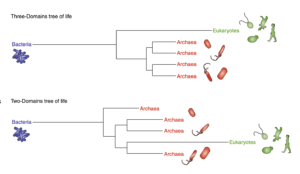Archaea
Archaea One of two prokaryotic (no nucleus) domains, the other being the Bacteria. Archaeans include organisms that live in some of the most extreme environments on the planet and resemble bacteria. Also they are single-cell organisms that, with bacteria, are called prokaryotes.
Their DNA is not enclosed in a nucleus. Bacteria and archaea are the only prokaryotes; all other life forms are eukaryotes. Archaeans are among the earliest forms of life that appeared on Earth billions of years ago. And it is believed that the archaea and bacteria developed separately from a common ancestor nearly 4 billion years ago.
Extremophiles:
Some archaeans are “extremophiles,”. That is, they live near rift vents in the deep sea at temperatures well over 100°C (212°F). Others live in hot springs (such as the hot springs of Yellowstone National Park, where some of archaea were first discovered) or in extremely alkaline or acid waters. They have been found inside the digestive tracts of cows, termites, and marine life, where they produce methane. Also live in the anoxic muds of marshes and at the bottom of the ocean and in petroleum deposits deep underground. They are also quite abundant in the plankton of the open sea and even have been found in the Antarctic. They survive in these harsh conditions by using a variety of protective molecules and enzymes.
Three groups of archaeans are known and include the Crenarchaeota, those that are extremophiles; the Euryarchaeota, methane producers and salt lovers; and the Korarchaeota, an all-inclusive group that contains a number of types that are little understood today.
Archaeans produce energy by feeding on hydrogen gas, carbon dioxide, and sulfur and can even create energy from the sun by using a pigment around the membrane called a bacteriorhodopsin that reacts with light and produces ATP.
The archaeans were not discovered as a separate group until the late 1970s.





